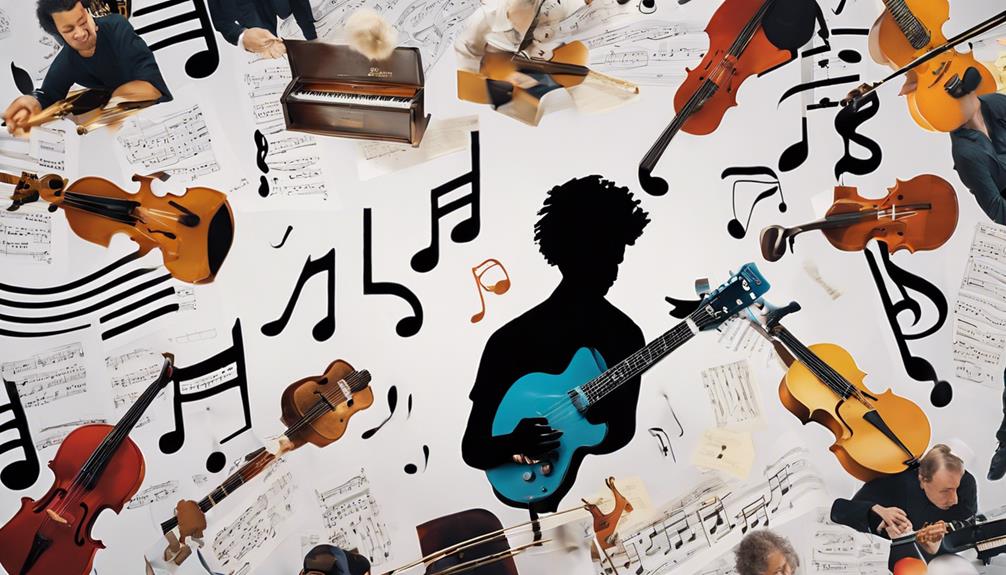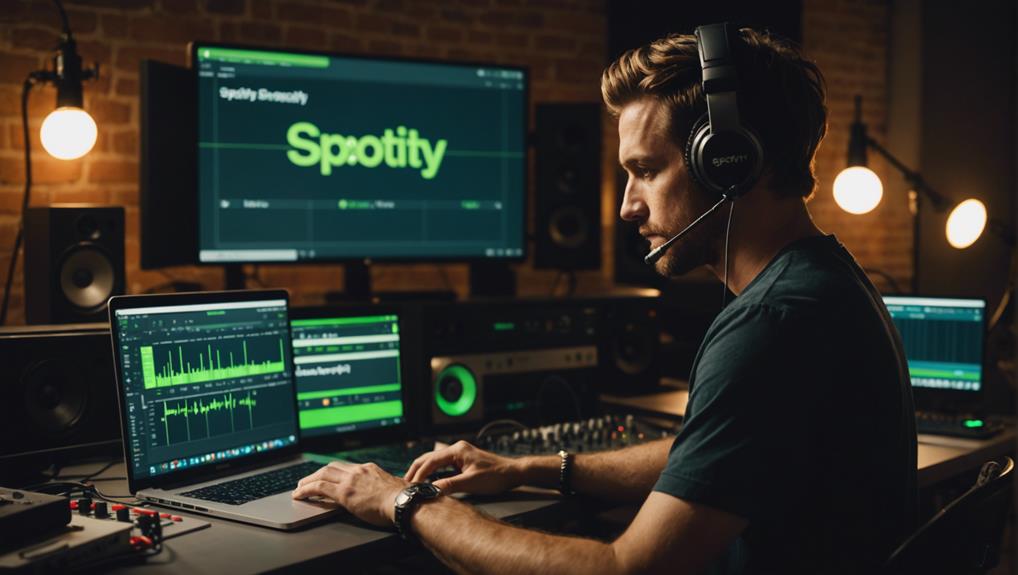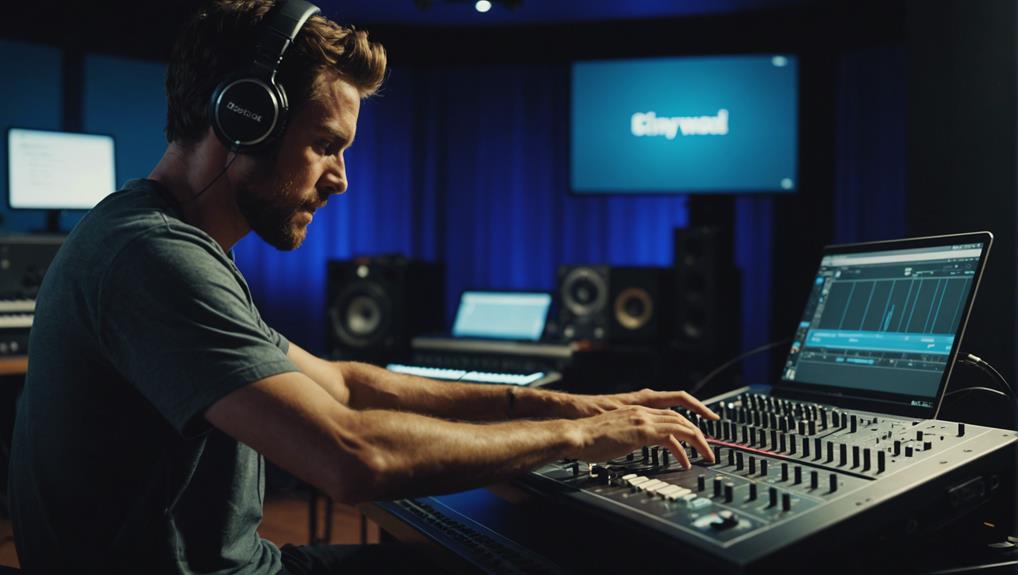When you’re maneuvering the music industry, understanding Performance Rights Organizations (PROs) is crucial for safeguarding your work and maximizing your earnings. PROs such as ASCAP, BMI, SESAC, and GMR are crucial in licensing your music, collecting royalties, and ensuring you’re compensated when your music is publicly performed. By affiliating with a PRO, you gain more than just financial benefits; you also access networking opportunities and legal support. So, how exactly do these organizations function, and which one might be the best fit for your career? Let’s explore the intricacies of PROs and their critical role in your success.
TL-DR
- PROs like ASCAP, BMI, SESAC, and GMR collect and distribute performance royalties for music creators.
- ASCAP and BMI are open to all music creators, while SESAC and GMR have exclusive, invitation-only memberships.
- PROs license musical works, ensuring legal use and proper compensation for public performances.
- Join a PRO to maximize revenue from public performances and access industry support and resources.
- Register as both songwriter and publisher with a PRO to ensure full royalty collection and avoid losing up to 50% of earnings.
What Are PROs?

Performance Rights Organizations (PROs) are entities that collect public performance royalties for songwriters and publishers. When your music is played in public venues, on the radio, or in businesses, these organizations guarantee you get paid for it.
They grant licenses for the public broadcast of songs and track each play to distribute royalties accurately.
As a songwriter or publisher, affiliating with a performing rights organization is essential. PROs work tirelessly to secure public performance rights, enabling you to maximize revenue from your music. Without their efforts, it would be challenging to track and collect earnings from the multitude of public performances happening daily.
These organizations serve as a bridge between music creators and the businesses that use your music. They handle the complex job of monitoring when and where your songs are played, ensuring that every public performance is accounted for. By doing so, PROs guarantee that you receive fair compensation for the public use of your music.
Key Functions of PROs
PROs play an essential role in guaranteeing songwriters and publishers receive their rightful earnings from public performances. When your song is played on the radio, performed live, or used in a business environment, PROs step in to collect royalties on your behalf. They do this by granting licenses for public performance and meticulously tracking song plays. These organizations guarantee that you, as a creator, get paid fairly for your work.
To break down their key functions:
- License Granting: PROs issue licenses to venues, radio stations, and businesses for the public performance of music.
- Royalty Collection: They collect royalties from these licensed entities and ensure the correct distribution to songwriters and publishers.
- Tracking and Monitoring: PROs keep track of song plays across various platforms to calculate and distribute royalties accurately.
Without PROs, tracking and collecting royalties for public performances would be nearly impossible, leading to significant losses for songwriters and publishers. Missing registration with a PRO could mean forfeiting up to 50% of your owed royalties, making it essential to be affiliated with one.
Major PROs in the U.S

You’ll find that the major PROs in the U.S., namely ASCAP, BMI, SESAC, and GMR, each offer unique benefits to their members. ASCAP and BMI have long histories and vast memberships, while SESAC and GMR operate on a more exclusive basis.
Understanding their differences helps you choose the best PRO for your needs.
ASCAP and BMI Overview
ASCAP and BMI, the two major Performance Rights Organizations in the U.S., play essential roles in guaranteeing songwriters and composers get paid for their work. These organizations are pivotal for collecting performance royalties, which are payments made to music creators when their works are publicly performed or broadcasted.
ASCAP, founded in 1914, represents over 800,000 songwriters and composers. It’s a member-owned organization that focuses on collecting performance royalties to distribute to its members. With such a vast network, ASCAP ensures that music creators are compensated fairly for the public use of their works.
BMI, established in 1939, boasts an even larger membership, exceeding 1.1 million music creators. Like ASCAP, BMI’s primary function is to collect performance royalties. It serves as a bridge between music creators and those who use their music, such as radio stations, TV networks, and digital streaming services.
Both ASCAP and BMI offer:
- Extensive royalty collection services for music creators
- Legal and advocacy support for artists
- Access to a wide range of networking and career development opportunities
These organizations are essential for maintaining the financial stability and creative growth of songwriters and composers across the United States.
SESAC and GMR Comparison
Let’s now take a closer look at SESAC and GMR, the other major Performance Rights Organizations in the U.S. SESAC, founded in 1930, operates as a for-profit PRO with an invitation-only membership. This exclusivity has helped SESAC build a catalog of diverse and popular music, representing established artists across various genres. Their tailored approach to artist relations sets them apart in the performance rights organizations landscape.
On the other hand, GMR, or Global Music Rights, is a relative newcomer, established in 2013. Despite its youth, GMR has quickly made a name for itself with its exclusive membership and a catalog of over 56,000 licensed songs. GMR’s focus on digital performance royalties and its innovative strategies have drawn significant attention, distinguishing it from traditional PROs.
When comparing SESAC and GMR, it’s clear both have unique strengths. SESAC’s long-standing reputation and broad artist representation contrast with GMR’s modern, digital-centric approach.
Together with ASCAP and BMI, SESAC and GMR contribute to the dynamic ecosystem of music licensing and royalty collection in the U.S., offering various services to meet the diverse needs of artists and rights holders.
ASCAP Overview
When you join ASCAP, you’ll be part of a community of over 800,000 music creators and publishers.
Understanding the royalty distribution process is essential, as ASCAP collects performance royalties on your behalf.
Let’s explore how membership eligibility works and how you can benefit from the royalties collected.
Membership and Eligibility
If you’re a songwriter, composer, or music publisher looking to join a reputable performance rights organization, ASCAP offers membership opportunities tailored to your needs. ASCAP, the American Society of Composers, Authors, and Publishers, has been around since 1914 and now boasts a membership of over 800,000 music creators and publishers.
This organization is dedicated to representing the interests of songwriters, composers, and music publishers by collecting performance royalties on their behalf.
To become a member of ASCAP, you need to meet some basic eligibility criteria. Membership is open to:
- Songwriters and composers who’ve written music that’s been performed publicly.
- Music publishers who publish the works of songwriters and composers.
- Anyone looking to protect and monetize their musical works through performance royalties.
Royalty Distribution Process
Understanding how ASCAP distributes royalties is crucial for any songwriter, composer, or music publisher aiming to maximize their earnings. As one of the leading Performance Rights Organizations (PROs), ASCAP focuses primarily on collecting performance royalties. With a membership exceeding 800,000, they manage an extensive network of music creators and rights holders.
The royalty distribution process at ASCAP begins when your music is performed publicly. This includes radio broadcasts, live concerts, TV shows, and even streaming services. ASCAP tracks these performances through sophisticated monitoring systems and data collection techniques. Once the data is gathered, ASCAP calculates the royalties owed based on the frequency and type of performances.
In 2020 alone, ASCAP distributed an impressive $891 million in royalties to its members. This substantial payout highlights the importance of understanding and navigating ASCAP’s royalty distribution process. Payments are made quarterly, ensuring a steady flow of income for music creators.
To get the most from ASCAP, you should regularly update your repertoire on ASCAP.com. Staying informed about your performance data and leveraging ASCAP’s resources can greatly boost your earnings. By mastering the ins and outs of ASCAP’s royalty distribution, you can better ensure your music translates into consistent financial rewards.
BMI Overview

Founded in 1939, BMI (Broadcast Music, Inc.) serves over 1.1 million songwriters, composers, and music publishers by collecting performance royalties. As one of the major PROs in the United States, BMI plays an essential role in ensuring that music creators are compensated whenever their work is played publicly, whether on radio, TV, digital platforms, or live venues. By joining BMI, you’re gaining a significant ally in the music industry.
Here’s what you can expect with BMI:
- Extensive Membership: With a vast network of over 1.1 million members, you’re in good company.
- Comprehensive Collection: BMI collects performance royalties from a variety of sources, ensuring you get paid for your work.
- Resource Access: Through BMI.com, members can access an array of tools, educational resources, and industry insights.
BMI’s commitment to its members goes beyond just collecting royalties; it also provides support and resources to help you navigate and succeed in the music industry. Whether you’re a seasoned professional or just starting out, BMI offers the tools and support you need to thrive.
Joining BMI means aligning with a PRO that has a long-standing reputation for advocating for music creators’ rights.
SESAC Overview
When considering SESAC, you’ll notice its exclusive membership by invitation only. This sets it apart with regards to eligibility and the benefits it provides for licensing and royalty distribution.
Let’s explore how SESAC’s personalized service and unique approach impact its members.
Membership and Eligibility Requirements
SESAC stands out as an exclusive performance rights organization, inviting only select songwriters, composers, and publishers to join its ranks. Unlike other PROs, SESAC’s membership is by invitation only, guaranteeing that the organization maintains a roster of high-caliber artists. To become a member, you must meet specific eligibility requirements based on your performance and financial success.
By joining SESAC, you’ll benefit from a range of tailored services, including personalized service that focuses on building direct relationships with its members. This individualized approach ensures that your unique needs and career goals are addressed effectively.
SESAC also provides detailed performance data, giving you in-depth insights into how your works are being used and how much you’re earning. This level of transparency helps you manage your royalties more efficiently.
Key advantages of SESAC membership include:
- Invitation-only access: Guarantees a selective and high-quality roster.
- Personalized service: Offers customized support and solutions for your career.
- Detailed performance data: Provides analytics to help you track your royalties and earnings.
Licensing and Royalty Distribution
Unlike other PROs, SESAC’s approach to licensing and royalty distribution is uniquely tailored to meet the specific needs of its exclusive membership. As a for-profit organization, SESAC operates by invitation only, focusing on a curated group of established artists and songwriters. This selective strategy allows SESAC to provide a higher level of personalized service, guaranteeing that each member receives focused attention and customized licensing solutions.
SESAC’s licensing process is designed to maximize the revenue potential for its members. By negotiating direct deals with broadcasters, digital platforms, and other music users, SESAC secures favorable terms that benefit its exclusive roster, which includes notable names like Adele, Bob Dylan, and Neil Diamond. This tailored approach ensures that licensing agreements are specifically suited to the diverse needs of its artists.
Royalty distribution at SESAC is equally personalized. In 2020 alone, SESAC distributed over $300 million in royalties to its members. The organization utilizes advanced technology to track music usage accurately and ensure timely payments. This precise monitoring and efficient royalty distribution system guarantee that members receive what they deserve, reflecting SESAC’s commitment to personalized service and financial transparency.
GMR Overview

Global Music Rights (GMR), founded in 2013, is an invitation-only performing rights organization known for its personalized services and exclusive membership. If you’re a songwriter or composer, GMR focuses on maximizing your performance royalties. Unlike larger PROs like ASCAP and BMI, GMR offers a more tailored approach to managing your music rights.
GMR represents a repertoire of over 56,000 licensed songs, guaranteeing that your work gets the attention it deserves. By concentrating on a smaller, selectively chosen group of members, GMR can provide a highly personalized service to its members. This focus allows them to dedicate more resources to collecting and distributing performance royalties effectively.
Here are some key aspects of GMR:
- Exclusive Membership: GMR’s invitation-only status ensures that only select artists receive their specialized attention.
- Personalized Services: Due to their smaller size, GMR offers more individualized support compared to larger PROs.
- Efficient Royalty Collection: GMR’s focused approach helps in efficiently managing and maximizing performance royalties for its members.
For more information, you can visit their official website at [globalmusicrights.com](http://globalmusicrights.com). GMR’s unique approach sets it apart in the world of performing rights organizations, making it a compelling choice for select music professionals.
Joining a PRO
Joining a PRO is vital for ensuring you receive the royalties you’re entitled to as a songwriter or composer. To start, you’ll need to register with the PRO of your choice. This step is essential if you write music for public consumption, as it guarantees you’re paid for the use of your work.
When joining a PRO, make sure you maintain a split sheet for any co-written songs to track ownership shares accurately. PROs typically split royalties 50/50 between songwriters and publishers. If you wear both hats, you’ll need to complete PRO registration twice—once as a songwriter and once as a publisher.
Missing PRO registration can be costly. Without it, you risk losing out on 50% of the royalties you’re owed. This is especially critical if your music is played frequently on the radio, in public venues, or streamed online.
Copyright and Royalties

How do you guarantee you’re adequately compensated for the use of your music? To start, you need to understand your music rights, which encompass both performance and mechanical royalties.
Copyright holders, including songwriters and publishers, earn royalties whenever their music is played publicly or reproduced. Performance royalties are collected by Performance Rights Organizations (PROs), which secure royalties to songwriters and publishers for their music being played in public venues. They track song plays and distribute the funds accordingly.
Mechanical royalties are managed by mechanical rights societies and are generated when your songs are reproduced or distributed, such as through streaming or physical sales.
To optimize your income from your music, consider the following:
- Register with a PRO: This safeguards your public performance royalties are collected efficiently.
- Understand mechanical royalties: Know that these are separate from performance royalties and require registration with mechanical rights societies.
- Stay on top of your rights: Regularly check your royalty statements and ensure all your works are properly registered.
How PROs Pay Artists
When you sign up with a PRO like ASCAP or BMI, they monitor public performances of your music to calculate royalties.
Each PRO has its own royalty distribution process and schedules payments at different intervals.
Understanding how often you’ll get paid and the specific distribution methods is essential for managing your income.
Royalty Distribution Process
Understanding the royalty distribution process of Performance Rights Organizations (PROs) is essential for ensuring you get paid for your music. PROs in the United States like ASCAP and BMI play an important role in this process. They track public performances of your music, collect royalties, and distribute them to you. These organizations split the royalties 50/50 between songwriters and music publishers.
To maximize your earnings, you might need to sign up with multiple PROs if you have different roles.
Here’s a quick overview of how the royalty distribution process works:
- Tracking Public Performances: PROs monitor various platforms and venues where your music is played, including radio, TV, live performances, and digital streaming services.
- Collecting Royalties: Once performances are tracked, PROs collect the royalties from the entities that use your music.
- Distributing Royalties: Collected royalties are then split and distributed to songwriters and music publishers, ensuring everyone gets their fair share.
For example, ASCAP distributed $891 million in royalties in 2020, while BMI distributed $1.233 billion. These figures highlight the significant role PROs play in ensuring you get paid for your creative work.
Sign up, monitor your earnings, and make sure your music is properly registered to benefit fully from the royalty distribution process.
Payment Frequency
Receiving payments from Performance Rights Organizations (PROs) is an essential aspect of managing your music career’s finances. Understanding the payment frequency of each PRO can have a substantial impact on your cash flow and financial planning.
Most PROs, like ASCAP and BMI, follow a quarterly payment schedule. This means you’ll receive your royalties four times a year, ensuring you have consistent income to manage your expenses.
ASCAP and BMI’s quarterly payments are predictable, helping you plan for regular income throughout the year. On the other hand, SESAC stands out by offering a monthly payment schedule. If you’re affiliated with SESAC, you’ll benefit from receiving more frequent payments, which can be particularly advantageous if you prefer smaller, steady streams of income.
Knowing the payment frequency of your chosen PRO can help you make informed decisions. For instance, if you desire more immediate cash flow, SESAC might be a better fit. However, if you’re comfortable with quarterly payments and value the stability offered by well-established organizations, ASCAP or BMI could be ideal.
Ultimately, aligning your financial needs with the payment schedules of PROs can help you manage your music career more effectively.
When to Join a PRO

Joining a Performance Rights Organization (PRO) is essential as soon as you start writing music for public performances to make sure you get your rightful royalties. By doing so, you guarantee that your work is properly tracked and compensated whenever it’s played publicly. Missing out on joining a PRO means you might lose up to 50% of the royalties you’re owed.
To stay on top of your earnings, consider these steps:
- Maintain a split sheet: For co-written songs, this document helps accurately distribute royalties among contributors.
- Register as both songwriter and publisher: This allows you to collect the full 100% of royalties, split evenly between the two roles.
- Join early: The sooner you register with a PRO, the sooner you start collecting what you’ve earned.
PROs typically pay royalties at a 50/50 split between songwriters and publishers. If you’re involved in both aspects, registering twice maximizes your royalty collection.
Don’t wait until your music is already out there; join a PRO early to avoid missing out on your deserved income from public performances. Taking these steps ensures you’re not leaving money on the table.
SoundExchange Explained
SoundExchange plays an important role in guaranteeing artists and labels receive their digital performance royalties. As a key player in the music industry, SoundExchange specializes in collecting royalties from non-interactive streams, which are those where listeners don’t select the songs themselves—think Pandora or satellite radio. This is essential for creators, as these digital performance royalties can add up considerably, providing a steady stream of income.
When you register with SoundExchange, you allow them to collect and distribute these royalties on your behalf. They focus solely on non-interactive streams, differentiating them from other PROs that might handle a wider array of performance rights. This targeted approach ensures that artists and labels get their due without the hassle of tracking down every digital play.
If you’re an artist outside the US, it’s important to note that SoundExchange’s reach is limited to the United States. Thus, you should look to similar neighboring rights organizations in your country to handle the collection of digital performance royalties. These organizations perform the same duties as SoundExchange but are tailored to their respective regions, ensuring you receive all the royalties you’re entitled to, no matter where your music is played.
Global PROs

As you navigate the landscape of performance rights, understanding the role of global PROs is vital to guaranteeing you receive all your due royalties. Global performance rights organizations (PROs) play an essential part in managing and collecting royalties for songwriters, composers, and music publishers worldwide. They ensure that your music is properly licensed and that you get compensated whenever your work is performed in public, broadcasted, or streamed internationally.
Global PROs include a diverse range of organizations, each with its own unique scope and membership criteria:
- ASCAP: Founded in 1914, ASCAP represents over 800,000 members, including songwriters, composers, and music publishers.
- BMI: Since 1939, BMI has been a significant player, with over 1.1 million affiliated songwriters, composers, and music publishers.
- GMR: Launched in 2013, GMR operates on an invitation-only basis with a catalog of over 56,000 licensed songs.
Understanding these global music publishing entities helps you leverage their vast networks to maximize your royalty collections. Whether you’re affiliated with a longstanding organization like ASCAP or a newer entity like GMR, these PROs ensure your creative work is protected and monetized globally.
Tips for Musicians
To guarantee you receive all your rightful earnings, it’s important to join a performance rights organization (PRO). Whether you choose ASCAP, BMI, or another PRO, this step guarantees you collect royalties whenever your music is publicly performed.
As a songwriter, you should always maintain a split sheet for co-written songs. This document clarifies how royalties are divided between songwriters and publishers, preventing any future disputes. Remember, PROs like ASCAP and BMI pay royalties on a 50/50 split basis between songwriters and publishers. Hence, it’s essential to have everything documented accurately.
If you also serve as your own publisher, be sure to register twice with your chosen PRO—once as a songwriter and once as a publisher. This dual registration ensures you receive the full 100% of your royalties, maximizing your earnings.
Missing out on PRO registration can be costly. You could lose up to 50% of your owed royalties for public performances. So, don’t overlook this significant step. Take control of your music career by joining a PRO and ensuring all your hard work as a songwriter is financially rewarded.
Next, learn how to upload music to spotify, apple music, tidal and more in this guide.



